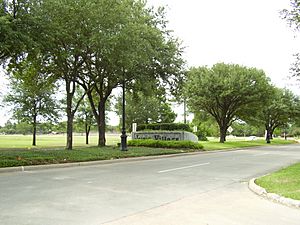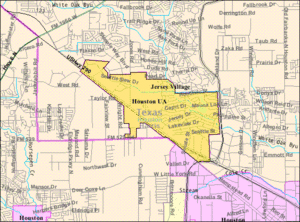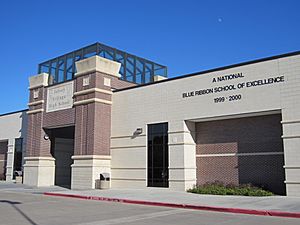Jersey Village, Texas facts for kids
Quick facts for kids
City of Jersey Village
|
|
|---|---|

Entrance to Jersey Village
|
|

Location in Harris County and the state of Texas
|
|
| Country | United States |
| State | Texas |
| County | Harris |
| Incorporated | April 16, 1956 |
| Area | |
| • Total | 3.43 sq mi (8.88 km2) |
| • Land | 3.38 sq mi (8.75 km2) |
| • Water | 0.05 sq mi (0.13 km2) |
| Elevation | 110 ft (33.5 m) |
| Population
(2020)
|
|
| • Total | 7,921 |
| • Density | 2,335.70/sq mi (901.70/km2) |
| Time zone | UTC-6 (CST) |
| • Summer (DST) | UTC-5 (CDT) |
| ZIP codes |
77040, 77041, 77065
|
| Area code(s) | 713 |
| FIPS code | 48-37612 |
| GNIS feature ID | 1360232 |
Jersey Village is a city located in west-central Harris County, Texas, in the United States. It is found near U.S. Highway 290, Farm to Market Road 529, and the Southern Pacific Railroad. This city is part of the larger Houston–Sugar Land–Baytown metropolitan area. In 2020, about 7,921 people lived there.
Contents
History of Jersey Village
Back in 1936, maps showed a few homes in the area that would become Jersey Village. A man named Clark W. Henry owned a large piece of land, about 1,236 acres. He used this land for his F&M Dairy, where he raised Jersey cattle.
When Mr. Henry's health declined, he decided to stop his dairy business. He made his land available for building a new community in 1953. In February 1954, Mr. Henry and LeRoy Kennedy started developing the area.
The new community quickly grew. It soon had about 5 miles of streets, along with services for drainage, gas, sewage, and water. The first families moved into their homes on Jersey Drive in late October 1954. The community also built a school, a park, and an 18-hole golf course.
Jersey Village officially became a city on April 16, 1956. All 58 people who voted agreed to make it a city. It even started with a volunteer police force. Because Jersey Village became its own city, the larger city of Houston could not take over its land.
In 1961, Jersey Village had 493 residents. On July 6, 1972, Leonard Rauch donated a building for the city hall. This building is now used by the fire department and public works. In 1977, the city decided to build a new city hall, a city garage, a park pavilion, and make the fire department building bigger.
The city's population continued to grow. In 1980, there were 966 residents, and by 1982, this number jumped to 4,084. In August 1986, the city voted to adopt a "home rule charter." This special charter gave Jersey Village more power to collect taxes and govern itself, more than it had as a general law city. By 1988, the population reached 5,143, and in 1990, it was 4,938.
Geography of Jersey Village
Jersey Village is located at coordinates 29°53′26″N 95°34′7″W / 29.89056°N 95.56861°W.
The city covers a total area of about 3.5 square miles (8.88 square kilometers). Most of this area, about 3.4 square miles (8.75 square kilometers), is land. A small part, about 0.04 square miles (0.13 square kilometers), is water.
People in Jersey Village
| Historical population | |||
|---|---|---|---|
| Census | Pop. | %± | |
| 1960 | 493 | — | |
| 1970 | 765 | 55.2% | |
| 1980 | 4,084 | 433.9% | |
| 1990 | 4,826 | 18.2% | |
| 2000 | 6,880 | 42.6% | |
| 2010 | 7,620 | 10.8% | |
| 2020 | 7,921 | 4.0% | |
| U.S. Decennial Census | |||
| Race | Number | Percentage |
|---|---|---|
| White (NH) | 4,113 | 51.93% |
| Black or African American (NH) | 906 | 11.44% |
| Native American or Alaska Native (NH) | 14 | 0.18% |
| Asian (NH) | 812 | 10.25% |
| Pacific Islander (NH) | 2 | 0.03% |
| Some Other Race (NH) | 24 | 0.3% |
| Mixed/Multi-Racial (NH) | 299 | 3.77% |
| Hispanic or Latino | 1,751 | 22.11% |
| Total | 7,921 |
As of the 2020 United States census, there were 7,921 people living in Jersey Village. There were 3,465 households and 2,217 families.
In 2000, the city had 6,880 people. There were 2,840 households, and 1,942 of them were families. About 29.0% of households had children under 18 living with them. Most households (59.6%) were married couples. About 24.8% of all households were made up of individuals living alone.
The average household size was 2.42 people, and the average family size was 2.94 people. The median age in the city was 38 years old. About 22.0% of the population was under 18.
The median income for a household in Jersey Village was $68,431. For families, the median income was $82,689. The average income per person in the city was $36,092.
Education in Jersey Village
Schools for Kids
Jersey Village is part of the Cypress-Fairbanks Independent School District. Most students living in Jersey Village attend Post Elementary School, which is located right in the city. After elementary school, students usually go to Cook Middle School and then to Jersey Village High School. Both of these schools are also in Jersey Village.
When Jersey Village High School first opened in 1972, it was a new high school site. Before that, students from Jersey Village went to Cy-Fair High School.
School Images
Colleges and Universities
Lone Star College serves the community of Jersey Village. This college system operates the Fairbanks Center, which is part of Lone Star College–CyFair. The Cypress-Fairbanks Independent School District joined the Lone Star College system in 2000.
Fun and Recreation
Jersey Village offers many fun activities for its residents. The city has a golf course where people can play. There's also a public swimming pool for everyone to enjoy.
The city has a public park with playground facilities for kids. There is also a small lake. This lake is owned and taken care of by a Homeowners Association. Residents and their guests who live near the lake can go fishing there.
Notable Person
- Gary Elkins was a Republican member of the Texas House of Representatives. He represented District 135 in Harris County from 1995 to 2018.
Images for kids
-
Jersey Village and its water tower seen from U.S. Highway 290
See also
 In Spanish: Jersey Village para niños
In Spanish: Jersey Village para niños





